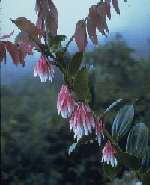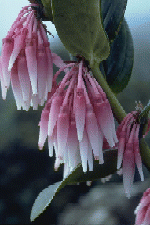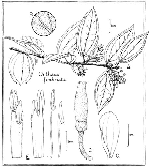- 7. Orthaea KLOTZSCH Linnaea 24: 23 (1851). -- Type: Orthaea secundiflora
POEPPIG
- & ENDLICHER.
Reference: LUTEYN, J. L., Orthaea
(Ericaceae-Vaccinieae): New species and redefinition of the genus. Nord. J. Bot.
7(1): 31--37 (1987).



Low shrubs, frequently epiphytic. Leaves alternate, evergreen, coriaceous to subcoriaceous,
the venation pinnate or plinerved. Inflorescence axillary, racemose, subfasciculate,
or 1--2-flowered; floral bract minute to sometimes large and showy, usually caducous; pedicel bibracteolate usually near the base. Flowers 5-merous, lacking
odor; aestivation valvate; calyx articulate with pedicel; hypanthium subcylindric
or campanulate, terete or 3-winged, sometimes basally apophysate; limb erect to
suberect, usually 5-lobed; lobes triangular, rarely 3 and then greatly enlarged; corolla
tubular to subcylindric, carnose when fresh but membranous when dry; stamen (8-)
10, alternately unequal, usually about 1/3 the length of the corolla; filaments
distinct or connate, sometimes only slightly coherent at the base, alternately unequal,
lacking spurs; anthers equal or alternately slightly unequal, basifixed, usually
lacking disintegration tissue, but rarely present (Guayana Highland species); thecae
smooth; tubules about the same width as the thecae but shorter, dehiscing by terminal or
slightly oblique pores; pollen without viscin threads; ovary inferior; style filiform,
about as long as corolla; stigma truncate. Fruit a berry.
Orthaea
is a neotropical genus of ca 35 species ranging from Mexico to Bolivia east to Guyana
and Trinidad.
Key to the Species of Orthaea
- 1a.
- Anthers dehiscing by subterminal, oblique pores; corolla densely pilose with eglandular
hairs
- .......................................................................................................O. fimbriata
- 1b.
- Anthers dehiscing by perfectly terminal pores; corolla glabrous or distally pilose
with glandular-tipped hairs.
- 2a.
- Staminal filaments distinct.
- 3a.
- Corolla 13--16 mm long
- ..................................................................................O. coriacea
- 3b.
- Corolla 29--40 mm long.
- 4a.
- Rachis moderately to densely provided with stout, gland-tipped hairs to 0.3 mm
long especially at base
- ..........................................................................O. oriens
- 4b.
- Rachis eglandular.
- 5a.
- Rachis 0.5--1 (-1.5) cm long; leaves apically short-acuminate
- ...............................................................O. abbreviata
- 5b.
- Rachis (1.5-) 2--4 cm long; leaves apically long-caudate-acuminate
- ...............................................................O. ecuadorensis
- 2b.
- Staminal filaments connate.
- 6a.
- Rachis 0.5--1 (-1.5) cm long
- ...................................................................................O. abbreviata
- 6b.
- Rachis (2-) 5--10 cm long.
- 7a.
- Inflorescence essentially glabrous in all parts; pedicel not greatly swollen
distally; calyx ca 4 mm long; corolla ca 25 mm long
- .........................................................................O. secundiflora
- 7b.
- Inflorescence (with rachis, bracteoles, calyx, corolla distally) provided with
glandular hairs; pedicel with distal end greatly swollen; calyx ca 6 mm long;
corolla ca 34 mm long
- ..........................................................................O. oedipus


